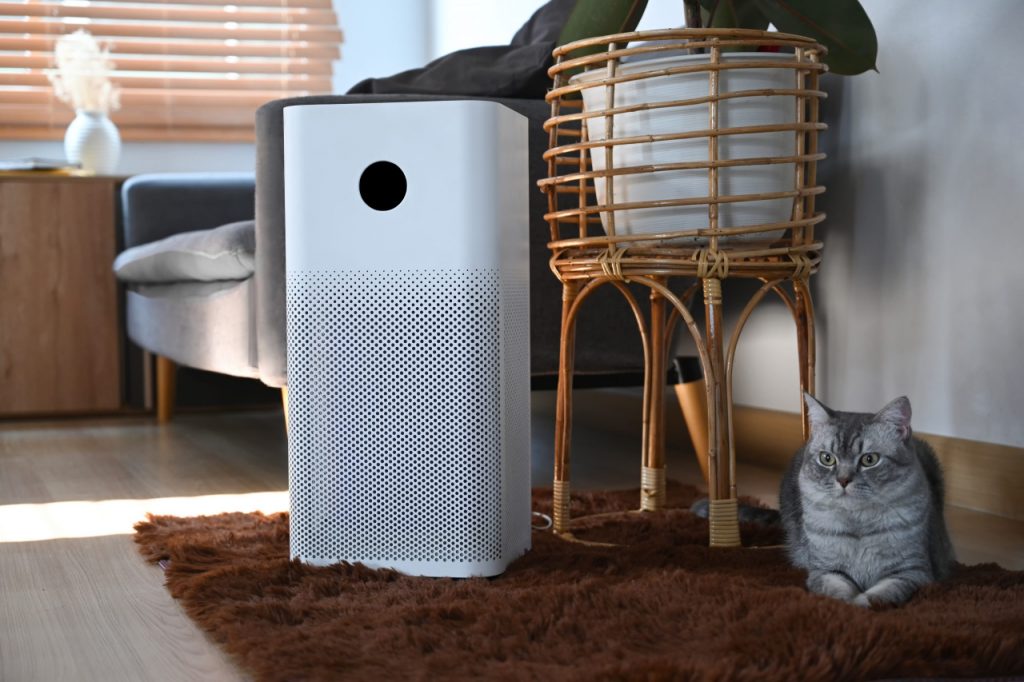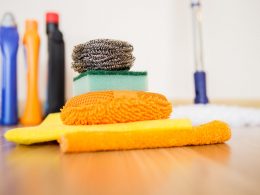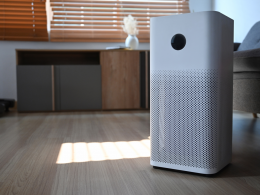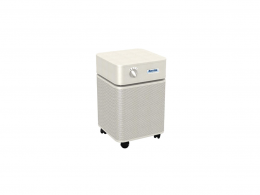The air quality or humidity in our homes and other indoor environments is not at a decent level most of the time. There are many types of devices that can fix that, such as air purifiers and dehumidifiers. But what is the difference between an air purifier and a dehumidifier?
To answer this question, we will analyze how these devices work, the types of filters they use, and how they affect our health. Moreover, we will compare the effectiveness of different conditions and give you general advice on which one to choose.
What Is the Difference Between an Air Purifier and Dehumidifier?
These two devices have completely different working systems. In this article, we will provide information about these two devices’ main characteristics, effectiveness, and technical composition.
Air purifiers
The need for using an air purifier increases day by day. These devices are effective in removing pollutants from the air we breathe. Their work system is simple; they suck the polluted air, filter it and then release it back into the environment. The benefits air purifiers provide to the health of the people living in the room where it is located have been evident and very realistic.
Air purifiers have many effects on human health. For example, during springtime, pollen floats around the air on a large scale, and that causes many symptoms in people with allergies. Also, viruses and bacteria spread various diseases amongst people, and decreasing the probability of that happening is something everyone wants.
We still must continue practicing other hygiene routines, though. Since it works with filters, the air purifier can only capture pollutants floating in the air, not on surfaces. The device itself must be cleaned to reach its full potential. Still, its effectiveness is not to be questioned, as it is proven to complete its duty with maximum rates. You can find more information on The U.S. Environmental Protection Agency.
Dehumidifier
While air purifiers work through filters to clean the air in our indoor environment and humidifiers add moisture to the air, dehumidifiers work differently than the first and are the opposite of the second.
The dehumidifier acts as a humidity reducer and regulator. While reducing the moisture levels from the indoor air, the dehumidifier effectively removes many pollutants.
We know humidity can contribute to rotting many of our everyday food supplies. Considering this, the usage of dehumidifiers is highly recommended. Besides that, dehumidifiers, by bringing the air moisture to the desired level, contribute to easing asthma symptoms and bring relief to the respiratory system.
Unlike air purifiers, dehumidifiers don’t require to be cleaned very often, mostly annually. Also, they are very quiet while working.
Types of Air Purifiers
Like many other technological devices, air purifiers come in numerous variants based on their filter type. Some air purifiers’ filtration systems are HEPA (High-Efficiency Particulate Air), Carbon Filtration, Negative Ionization, and UV Light. Each of these filters works differently and affects the air quality differently. In the following, we will provide you with information on how these filters work and their best results.
HEPA filtration

HEPA (High-Efficiency Particulate Air) is one of the most effective mechanical filters that an air purifier works with. HEPA filters belong to the list of the best filters on the market right now. The effects that they provide have proven to be remarkable. Since they capture many particles of really small size, their effects are easily noticed.
Carbon filtration
Carbon filters work differently from HEPA filters. The carbon surface is a compound of many pores that make it a very effective filter. These pores let the clean air get through while the pollutants get stuck in the walls. This means that the more pores the surface contains, its effectiveness increases, and more pollutants are captured. This makes carbon filters another effective tool to contribute to indoor air quality.
Negative ionization
Negative ionization filters work with more specific chemical processes than the others. The device releases negative ions into the air, creating compounds with positive ions in the air. When they get connected, they fall together as one, making it easier for the residents to manually remove the pollution from surfaces. Through this process, the air gets cleaner.
The National Library of Medicine has conducted an in-depth study on the effectiveness of Negative Air Ions and Their Effects on Human Health and Air Quality Improvement, which can help gain a deeper understanding of the matter.
Ultraviolet (UV) light
Ultraviolet light is another very effective type of air purifier. Among other device types, this one works differently because it uses light waves to reach its effectiveness. They release short UV waves to irradiate pollutants from the air. They work against mold spores, viruses, and bacteria and are a great choice as an air purifier. When active, they emit 200-280nm wavelengths of light, and that’s the most lethal spectrum of light against germs.
They’re appropriate as an additional method of cleaning surfaces around your house and keeping the air quality on desired levels. More information can be found on Disinfecting Surfaces with UV Light.
Types of Dehumidifiers
Like most devices that contribute to air quality, dehumidifiers also have several existing variants in the market. They vary from each other by the way they function and their effects. Some of the most used dehumidifiers are refrigerant, desiccant, and electronic. We will analyze and explain how each device works and its abilities in the following.
Refrigerant
Refrigerant dehumidifiers work at a very high effectiveness and energy efficiency rate. Their system of work is very complex, which explains its efficacy. The moist air passes through an evaporator, where it gets condensed and drained away. After that, the air passes through a heater and returns to space.
This type of dehumidifier is appropriate for production areas, clothing, kit drying rooms, aircraft hangars, etc. It is reliable and quiet while working, making its presence effective and nearly unnoticeable.
Desiccant
The desiccant dehumidifier works differently compared to the refrigerant. Desiccants use vapor-absorbing materials to complete their function. One of the materials that are more commonly used is silica gel. This dehumidifier is equipped with a rotor that works on a cycled process. It sucks water vapors inside, and a fan moves the air through the desiccant, where it gets dehumidified. After that, the air is spread back to the environment, and the moisture is significantly reduced.
How Do Air Purifiers and Dehumidifiers Impact Your Health?
Most of us spend a lot of time indoors, and while standing there, we need clean air. The usage of air-cleaning devices is becoming a necessity. As mentioned earlier, air purifiers are devices that remove pollutants from the air through filters of many variants and models. By doing this, air purifiers fight allergens, mold spores, viruses, and bacteria, thus improving one’s health.
On the other hand, dehumidifiers reduce moisture from the air. Many types of dehumidifiers work differently but have the same goals. High air moisture levels are not desirable for our indoor environment as they allow harmful particles to move around. Dehumidifiers keep moisture levels normal and positively contribute to one’s health.
Air Purifier vs. Dehumidifier: Which Works Better for Different Conditions?

Air purifiers and dehumidifiers have different ways of functioning. Of course, for various conditions, the effectiveness of one can overcome the other. We will compare air purifiers and dehumidifiers in different situations in the following.
We will specifically look at the effectiveness of one and the other on babies, allergies, and asthma. That way, we will provide a better understanding and more accessible choices based on your needs.
Air purifier vs. dehumidifier for babies
Both devices positively contribute to your baby’s health. But when looked at more deeply, an air purifier is the best choice for babies. To clarify this claim, we will lay out some facts.
A good air purifier allows your baby to breathe clean air, considering that they offer up to 99% effectiveness in air cleaning, thus decreasing allergens and asthma complications.
The benefits of the air purifier continue with odor removal, which is a much-needed service while raising babies due to the need to change diapers often.
Dehumidifiers, on the other hand, work by removing excessive moisture from the air; however, they do not contribute much to the purity of the air your baby breathes. So, if air quality is more important for you than decreasing humidity, an air purifier is the better option.
Air purifier vs. dehumidifier for allergens
For allergens, both air cleaning devices can be effective. Air purifiers help remove allergens from the air and reduce their effects, but for allergens to rise and prosper, the air moisture must be over 65%. That’s where the dehumidifier comes in handy. Dehumidifiers are programmed to keep air moisture levels below that percentage, making it unavailable for allergens to affect our health.
But still, air purifiers’ impact can be much higher since they actually remove many allergens from the environment. So, we suggest using both an air purifier and a dehumidifier to combat allergens best. But if you must choose, go for an air purifier.
Air purifier vs. dehumidifier for asthma
Air cleaning devices help relieve asthma symptoms. While air purifiers clean the air and contribute to asthma complications by removing pollutants from the air, the dehumidifier, while maintaining moisture in the air, makes sure for the best humidity levels that help on asthma symptoms release as well.
However, if you’re only going to choose one, an air purifier is usually the best choice for those who have asthma.
Air Purifier vs. Dehumidifier: Which One Should You Choose?
Air purifiers offer more services to your indoor air quality than a dehumidifier; attacking, capturing, and removing pollutants from the air is a rather impressive task. The air purifier targets allergens, mold spores, viruses, bacteria, and other germs and effectively restricts them.
The dehumidifier, on the other hand, regulates the moisture of the air. Still, its effectiveness is a little lower than that of the purifier, even though it also helps the respiratory system and air quality in general.
When it comes to choosing one of them, comparisons line up the air purifier as a better choice to increase the indoor air quality in the environments we live, work, or study in.
Can You Use Both an Air Purifier and Dehumidifier Together?
Yes, of course, they can be used simultaneously in the same room as they complement each other. The air purifier does its job by removing contaminants from the air while the dehumidifier confronts other problems that are wet-air related. Together, they give you the best indoor air quality.
The Bottom Line
Considering the air quality nowadays, using air-cleaning devices is becoming almost inevitable. Taking concrete steps to remove various pollutants from the air and preventing the presence of other complications is a gift for our health and our future.
Since there are various devices that contribute to the air quality in a house, you must research and choose wisely what kind of device you choose. Depending on your needs and desired results, air purifiers and dehumidifiers can contribute to your health in many ways, so we say they are definitely worth it!










